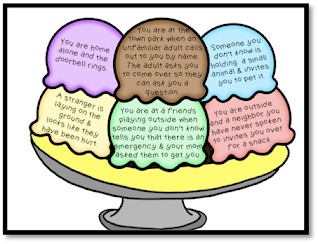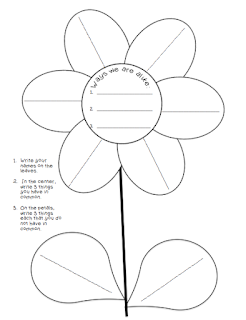Chilling Tales and Safety Dreams
Personal safety is a crucial topic when it comes to teaching young children. Just recently, we had a horrific situation with a young child being abducted in our community. As times change, the traditional approach of "Stranger Danger" may not be the most effective method. I wanted my students to be aware of deceptions and dangers. I wanted to give them the knowledge they need to make informed decisions in potentially dangerous situations. By focusing on identifying possible dangers, learning safety rules, and seeking help from trusted adults, I aimed to empower my young students to make smart choices and stay safe in real-life situations.
To begin, I sparked curiosity by asking students, “What does a stranger look like? How would you keep yourself safe from a stranger?” I’m sure you can imagine some of the answers I got! One of my favorites was, “If a stranger tries to hurt me, I will Karate chop them!” While I find that courageous, it also reinforced how important this lesson really is. So I quickly redirected their attention and emphasized the importance of staying safe without getting caught by tricks!
To introduce the key safety rules, I used Julia Cook's book, "Smarter than the SCOOPERS," This book teaches personal safety through an entertaining story about outsmarting tricky situations and making smart choices.
Safety Rules to Scoop Up
"S - Smart: Be smart and confident, and trust your instincts. Listen to your 'Uh Oh' voice.” Encourage students to develop their awareness and intuition, empowering them to recognize potential dangers and trust their instincts.
"C - Call List: Always call first so that you make the right choice.” By teaching children the importance of seeking guidance from trusted adults before making decisions, we equip them with the tools to make safe choices.
"O - Zero Talking: Do not talk to grown-ups that you don’t know well. Look for the adults who can help, like moms with kids, workers with name tags, police officers, etc."
Guide children in identifying safe and trustworthy adults they can approach for help in unfamiliar situations.
"O - Out: Keep people out of your personal space.” Respecting personal boundaries is essential! Emphasize the importance of maintaining personal space to feel safe and secure. Demonstrate how getting too close puts a child in danger of being grabbed.
"P - Pair Up: Always go places with a friend.” Encourage children to have a buddy system, and never play outside or leave the house alone.
Sprinkling the Learning with Interactive and Engaging Activities
To reinforce the safety rules, we played a game called Brain Freeze. Together, we practiced identifying safe and unsafe situations, applying the personal safety tips we learned. An example of one scenario is, “You are outside playing when an adult you do not know stops their car and ask if you have seen their lost dog. They have a picture on their phone they want to show you, so you go over to the car to see the picture of the lost dog.” Students select if the child in this scenario chose the safe or unsafe response to the stranger. By discussing these situations as a class, critical thinking skills are encouraged and students internalize the safety strategies for potential deception and danger.

To further enhance their understanding, the class was divided into small groups. Each group discussed a Sundae Fun Day Situation. One example of a Sundae Situation is, “You are outside, and a neighbor you have never spoken to invites you over for a snack.” Together students collaboratively decided on the best course of action to stay safe. Using the animated PowerPoint, we built an ice cream sundae as each group shared their scenario and how they would stay safe if ever to be in that dangerous situation. By sharing their ideas, students learned from one another's perspectives and expanded their knowledge of personal safety choices.
Sweet Reminders: Creating Page Corner Bookmarks
As a creative finale, students unleashed their artistic skills by making page-corner bookmarks. This hands-on activity served as a delightful reminder of the SCOOP safety tips they had learned. Each time they open a book and see their personalized bookmark, they will be reminded of the importance of staying vigilant and seeking help when needed!
Empowering Young Minds
Above all, it is School Counselors’ goal to empower young students to evaluate situations critically and ask for help when they feel unsafe. We emphasize that not all strangers are dangerous and encourage children to look for helpers when they need adult assistance.
Learning Outcomes
At the end of this engaging lesson, students achieve the following learning outcomes:
- Identify trusted adults
- Identify strategies to be used when in an unsafe situation
- Demonstrate personal safety skills
- Demonstrate the ability to assert oneself when necessary
Benefits for Children
- Increased Awareness: Children become more aware of personal safety and potential dangers in different situations.
- Empowered Decision Making: They gain the knowledge and tools to make smart choices when faced with unfamiliar or potentially dangerous circumstances.
- Trusting Instincts: Children learn to trust their instincts and respond appropriately to warning signs.
- Critical Thinking Skills: Engaging activities help children develop critical thinking skills to analyze and judge their safety.
- Boundaries and Personal Space: Children understand the importance of setting and respecting personal boundaries, promoting autonomy and security.
Benefits for Teachers
- Effective Teaching Approach: Engaging and interactive lessons resonate better with children, making the learning experience more effective.
- Enhanced Classroom Discussions: Discussions create a safe space for students to express their thoughts and concerns about personal safety.
- Encouraging Collaboration: Group activities foster collaboration and peer learning as students discuss and generate safety strategies.
- Creative Expression: Artistic activities reinforce safety tips while allowing students to express their creativity.
- Tangible Learning Outcomes: Teachers can assess students' ability to identify trusted adults and apply safety strategies.
Ready to Use Resource
Are you ready to safeguard your young students and empower them to make smart choices? Shop here for this resource:
Looking for more lessons on Personal Safety? Check out this one:









































